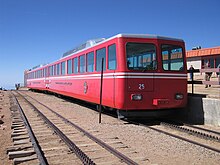MG Bhm 2/4
| MG Bhm 2/4 | |
|---|---|
| Numbering: | Bhm 2/4 |
| Number: | 2 |
| Manufacturer: | SIG , Büssing |
| Year of construction (s): | 1957 |
| Gauge : | 800 mm |
| Length over buffers: | 15.030 mm |
| Length: | 14,500 mm |
| Width: | 2,200 mm |
| Trunnion Distance: | 9,700 mm |
| Bogie axle base: | 1.780 mm |
| Total wheelbase: | 11,480 mm |
| Empty mass: | 15.4 t |
| Service mass: | 16.0 t |
| Top speed: | 16 km / h ascent; 12 km / h descent |
| Continuous output : | 360 hp |
| Driving wheel diameter: | 692 mm |
| Impeller diameter: | 600 mm |
| Number of traction motors: | 2 |
| Drive: | mechanically |
| Seats: | 60 |
The Bhm 2/4 3 + 4 are cog railway - railcars of Monte Generoso Railway (MW) were built in two copies.
history
After the diesel operation of the Monte Generoso Railway (MG), ( it . : Ferrovia Monte Generoso), officially Ferrovia Monte Generoso AG , with the Hm 2/3 1 + 2 in. Diesel locomotives that were created in 1954 from the H 2/3 5 + 6 steam locomotives was successfully introduced in a first step, the two diesel-mechanical cogwheel railcars Bhm 2/4 3 + 4 were procured to supplement the thermal vehicle fleet.
In 1981 the two Büssing engines of the Bhm 2/4 4 were replaced by MAN diesel engines with 225 hp, and the necessary modifications to the gearbox were made by the Saurer company . This also increased the permissible speed of this railcar when traveling uphill to 18 km / h.
Both railcars have since broken off.
construction
drive
Two Bussing diesel engines each with 132 kW at 1900 / enabled via an electro-connected 5-speed gearbox not only the railcar itself, but also a Vorstellwagen of 5 t total weight carried. With a 5 t payload of the railcar, a permissible total weight (railcar and front car) of 26 t could be transported up the mountain. The two diesel engines as well as the gearboxes were installed under the floor of the car between the bogies. An exhaust engine brake was available as a service brake for the descent. In addition, the diesel railcars had the usual braking systems to safely stop the entire train in any situation. Among other things, a ratchet band brake acting on the drive gears and a disc brake acting on the countershaft.
Car body and passenger compartment
Since the entire interior of the railcar body could be used as a passenger compartment, the total of 60 seats in the 2 + 2 arrangement make full use of the passenger compartment. Six seats each were in an excellent, passenger-friendly location in the direction of travel next to or directly behind the driver's cab, which provided an excellent view of the route. The large lowered windows that were common in Switzerland at the time allowed an excellent view to the outside. Initially, both railcars were painted red / cream. The Bhm 2/4 4 railcar, which was later fitted with new engines, received the same orange / blue paintwork as the Bhe 4/8 11-14 geared twin railcars acquired for electrification .
Rack-and-pinion railcar of a similar design
The diesel railcars were of a similar design to the standard-gauge, diesel-electric rack- and -pinion railcars of the Manitou and Pike's Peak Railway , now also known as the Pikes Peak Cog Railway, which were later repeatedly procured from 1963 .
The diesel-hydraulic, meter-gauge rack-and-pinion railcars Bhm 2/4 5099.001 + 5099.002, which were procured in 1964 by the Austrian Federal Railways (ÖBB) for the Schafbergbahn from Sankt Wolfgang to the Schafberg (Schafbergspitze), now operated by Salzburg AG , were of a similar design.

